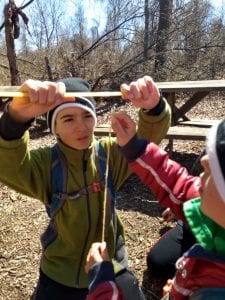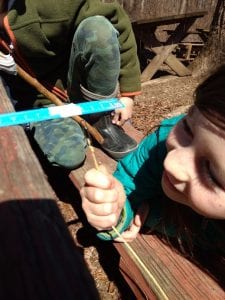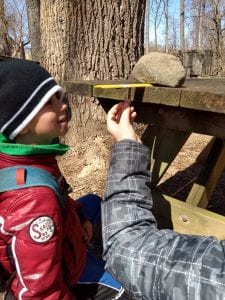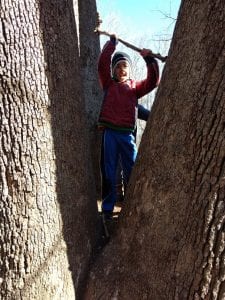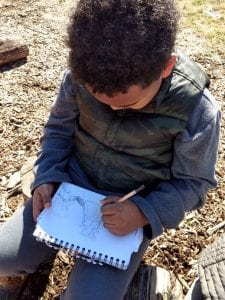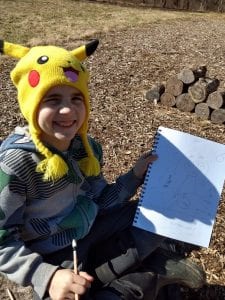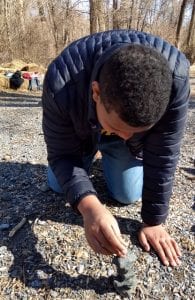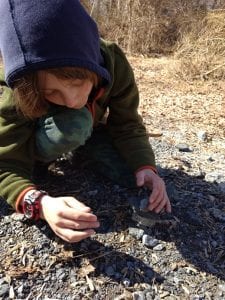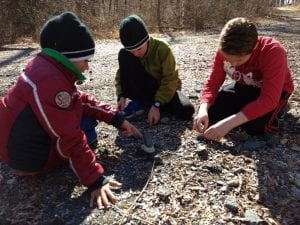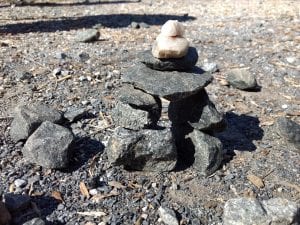3/26/2019
Today we introduced a new and fascinating land artist, Michael Grab. Michael Grab creates art by delicately stacking rocks in mind-blowing positions. The balancing feats he pulls off look unreal but they are real. We looked at some of his most famous works of arts and put them in our journal, wondering how he does it. Below is a picture of our featured artist and one of his more simple rock stacking examples (yes that is a simple one). A link to his stunning website is below the image.

So how does he do it? There is no simple answer but the force he uses to hold these rocks together is opposite of what you may think, gravity. Most of us think of gravity as a way to pull something towards Earth, keep thinks from going up, or even a force that can knock something over that isn’t balanced well, so how does Michael Grab use gravity to hold rocks up? Well, by finding their center of gravity and studying each rock’s individual nooks and crannies and finding the best way to use that rock in a rock stack are a few ways. Gravity helps push those rocks into each other but not so much that they fall over.
As a class we did a simple, yet fun experiment on gravity by using a magnet and a paperclip attached to a string. The magnet needs to be strong enough to “suck” the paperclip toward it in midair. We practiced trying to get the paperclip just the right distance from the magnet so that it would “float.” A similar patience and precision is needed to practice rock stacking. It takes a delicate hand and technique to get it just right.
Next, we hiked to the gazebo and stopped for a snack and share and then played a fun stone passing game. In this game everyone sits in a circle with their legs crossed and their knees almost touching their neighbors. You anchor your left hand to your left knee with your hand cupped and then you use your right hand to pass the stone around the circle. While you’re passing the stone you’re singing a simple song to help keep the rhythm and someone in the center of the circle is trying to discover where the stone is. Their goal is to find the stone before the song ends or they can make a guess as to who has it at the end. After a few rounds of the game we packed up and hiked down the meadow to the seven sycamore tree. We spent a few minutes here before making our way to the Native American site where we thought more about our featured natural item of the day, rocks.
How old are rocks? If you find a rock on the ground has it always looked like that? Where did that rock come from? A lot of these questions can be answered with the rock cycle. What is the rock cycle? First we brainstormed some other types of cycles like life cycles and even water has a cycle. But how does the rock cycle work? Last week we talked about the three types of rocks, sedimentary, metamorphic and igneous and where they come from. Those three types of rocks have everything to do with the rock cycle. For example, rocks can start as liquid rock, or magma in the Earth’s crust. That magma can crystallize and then later be brought to the surface or be ejected out of a volcano where it cools into a rock. Those rocks then go through weathering (breaking down into smaller rocks by wind, water, snow, etc), turn into smaller particles and then eventually land in rivers and lakes. After millions of years, layers form. Those layers push down on each other forming sedimentary rocks. As those layers get deeper and deeper in the Earth, heat and pressure will then turn those rocks into metamorphic rocks. Plate tectonics can then move those rocks back to the surface or they can melt into magma again and the cycle continues. Below is an image we used to show the rock cycle.
After a quick review of the rock cycle and an image to help us out, we journaled our own versions of the rock cycle, labeling each type of rock where it would be found in our rock cycle. With a better understanding of rocks, we hiked up the road and stopped at a spot along the road that had a lot of rocks that we could use for our rock stacking art. Most of the rocks that we were stacking with were metamorphic rocks like granite and gneiss. There were also a lot of small pieces of quartz (a mineral). We had 10 minutes to create our own rock stacking art inspired by Michael Grab. We could also use this time to challenge ourselves to a rock stacking challenge and see how many rocks we could stack up (only stacking one rock for each layer). A lot of us got around 8-10 rocks! We hope to try some rock stacking at a stream next time, just like Michael Grab.
Check out some of our rock creations below!
